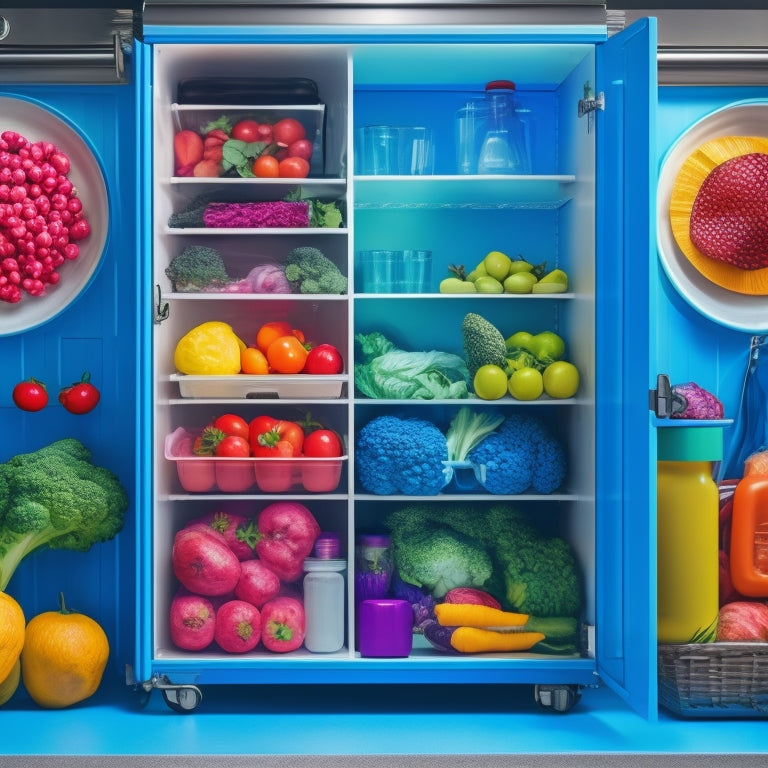
Extend Veggie Lifespan With These Hacks
Share
Proper storage and handling techniques can greatly extend the shelf life of vegetables, allowing them to remain fresh, nutritious, and flavorful for a longer period. Mastering the basics of veggie storage, understanding specific storage needs for various produce types, and utilizing the right containers and tools can make all the difference. By incorporating clever hacks, such as removing excess moisture from leafy greens and storing vegetables in cool, dark places, you can further prolong freshness. By revealing the secrets of veggie preservation, you'll be able to enjoy your favorite vegetables for a longer period while minimizing food waste.
Key Takeaways
• Remove excess moisture from leafy greens to prevent spoilage and extend shelf life.
• Store vegetables in cool, dark places to slow down their metabolic process and prolong freshness.
• Use the right container for each vegetable type, such as ceramic crocks for carrots and glass jars for alliums.
• Employ clever hacks like trimming carrot tops and storing celery in a shallow cup of water to maximize freshness.
• Implement effective preservation techniques, such as breathable lids and reusable produce bags, to reduce food waste and extend veggie lifespan.
Mastering Veggie Storage Basics
Proper storage is the key to revealing the full flavor and nutritional potential of your fresh vegetables, and it all starts with understanding the unique needs of each variety.
By adopting creative preservation methods, you can greatly reduce food waste and enjoy your veggies for a longer period.
A well-stocked pantry and refrigerator are essential for maintaining the freshness of your produce. Learning the specific storage requirements of each vegetable will help you make the most of your grocery haul.
From crunchy carrots to vibrant leafy greens, every veggie has its own set of needs. By mastering the basics of veggie storage, you'll be on your way to reducing food waste and savoring the flavors of your favorite vegetables for weeks to come.
Tips for Specific Vegetables
From delicate leafy greens to robust root vegetables, each type of produce has its unique storage requirements, and understanding these nuances can greatly extend their shelf life.
For instance, carrots need their tops cut off and stored in a closed container with plenty of moisture, while celery thrives in a shallow cup of water on the counter or in the refrigerator.
Summer squash and zucchini can be left on the counter, wrapped in a cloth for longer storage, whereas eggplant prefers to stay dry until ready to use.
Storage Containers Matter
When it comes to storing vegetables, the right container can make all the difference in maintaining their freshness and shelf life. It's not just about tossing them in any old container and hoping for the best. The key is to choose a container that complements the vegetable's specific needs.
For instance:
-
Ceramic crocks are perfect for carrots, keeping them cool and moist.
-
Open containers with a damp cloth are ideal for beets, allowing them to 'breathe' while staying hydrated.
-
Cool, dark places are a must for alliums like garlic and onions, while tomatoes thrive on the counter.
- Celery loves a small cup of water in the refrigerator, keeping it crisp and fresh.
Maximizing Shelf Life Hacks
Ideal storage conditions are just the beginning, as savvy vegetable enthusiasts know that a few clever hacks can greatly extend the shelf life of their prized produce. By employing effective vegetable preservation techniques, you can enjoy your veggies for longer.
For instance, removing excess moisture from leafy greens like kale and spinach can prevent spoilage. Similarly, storing vegetables like carrots and beets in a cool, dark place can slow down their metabolic process, maintaining their freshness.
Freshness maintenance strategies like these can make a significant difference in the longevity of your vegetables. By incorporating these hacks into your routine, you can savor your veggies for a longer period and reduce food waste.
Essential Storage Tools
Proper storage tools are the unsung heroes of vegetable preservation, providing the ideal environment for your produce to thrive. By investing in the right containers, you can creatively preserve your veggies and extend their lifespan.
Here are some essential storage tools to add to your arsenal:
- Ceramic crocks for keeping carrots cool and moist
- Handmade bowls with lids for storing beets and other root vegetables
- Glass jars with breathable lids for preserving alliums like garlic and onions
- Reusable produce bags for storing leafy greens like kale and spinach
These sustainable solutions will help you keep your produce fresh for longer, reducing food waste and saving you money. With the right storage tools, you can enjoy your favorite veggies for weeks to come!
Frequently Asked Questions
Can I Store Multiple Types of Vegetables Together in One Container?
When it comes to storing multiple types of vegetables together, achieving veggie harmony is essential.
A well-designed container is vital to prevent moisture and flavor transfer between vegetables. Avoid mixing high-moisture vegetables like carrots and celery with low-moisture ones like onions and garlic.
Instead, group vegetables with similar storage requirements together. With thoughtful container design, you can create a harmonious storage space that extends the lifespan of your veggies.
How Often Should I Check on Stored Vegetables for Spoilage?
It's no coincidence that the most vigilant veggie enthusiasts maintain a 'Veggie Diary' to track their produce's progress.
To avoid spoilage, schedule regular checks every 2-3 days for high-moisture vegetables like celery and carrots, and every 5-7 days for lower-moisture varieties like onions and garlic.
Create a 'Spoilage Schedule' to make sure you're staying on top of your stored veggies, and enjoy a longer, healthier lifespan for your prized produce.
Can I Freeze Vegetables Instead of Storing Them in the Refrigerator?
When considering freezing vegetables, it's important to understand the process to avoid freezer burn. Flash freezing is the key to preserving nutrients and texture.
Quickly chill vegetables to 0°F (-18°C) or below to prevent ice crystals from forming.
Proper packaging, airtight containers, and labeling are also vital.
Do Organic Vegetables Have Different Storage Requirements Than Non-Organic?
Did you know that the average American throws away 40% of the food they buy?
Now, onto the question at hand: do organic vegetables have different storage requirements than non-organic?
The answer lies in the soil impact and farming methods. Organic farming tends to use more natural and sustainable practices, which can result in slightly different storage needs.
However, the difference is minimal, and general storage tips, such as keeping carrots cool and moist, apply to both organic and non-organic veggies.
Can I Reuse Containers That Previously Held Spoiled Vegetables?
When reusing containers that previously held spoiled vegetables, cleanliness importance cannot be overstated. It's essential to thoroughly sanitize the container to prevent the spread of bacteria and contamination.
Wash the container with soap and warm water, then rinse and dry it completely before reuse. This container sanitation step is important to guarantee the longevity of your fresh produce.
Don't risk spoiling your new veggies – give those containers a good scrub!
Related Posts
-

Why Cluttered Bedrooms Are a Thing of the Past
You've finally said goodbye to cluttered bedrooms, thanks to innovative storage solutions that have revolutionized th...
-

Mastering Small Closet Organization: Proven Strategies Unlocked
You're about to reveal the secret to transforming your small closet into a functional haven, where every item has its...
-

Why College Students Need Smart Storage Systems
As you navigate the challenges of college life, you'll quickly realize that a smart storage system is essential to tr...


